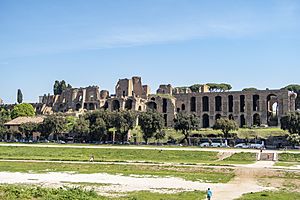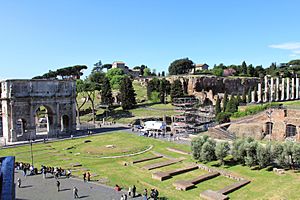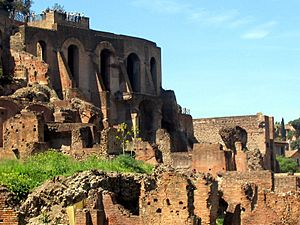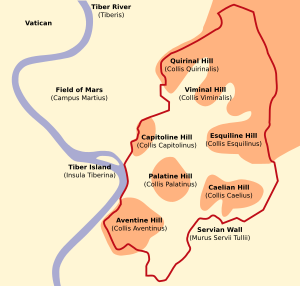Palatine Hill facts for kids
Quick facts for kids The {{{name}}} |
|
|---|---|
| One of the seven hills of Rome | |
| Latin name | Palatium; Collis Palatinus |
| Italian name | Palatino |
| Rione | Campitelli |
| Buildings | Flavian Palace |
| People | Cicero, Augustus, Tiberius, Domitian |
| Events | Finding of Romulus and Remus |
| Ancient Roman religion | Temple of Apollo Palatinus, Temple of Cybele, Lupercalia, Secular Games |
| Mythological figures | Romulus and Remus, Faustulus |

The Palatine Hill is the most central of the seven hills of Rome. It is one of the oldest parts of the city. Many people call it "the very first place where the Roman Empire started."
Today, the Palatine Hill is mostly like a huge outdoor museum. The Palatine Museum is also there. It shows off many cool things found during excavations on the hill and from other ancient Italian places.
Important Roman emperors, like Augustus, built their huge palaces here. Before emperors took over, rich Romans lived in fancy houses on this hill.
Contents
What's in a Name?
The name of the Palatine Hill is where the word "palace" comes from! Think about it: Palatine Hill, then palace. This connection exists in many languages around the world.
Another interesting word, "paladin", also comes from the Palatine Hill. A paladin was a brave and distinguished knight, especially one of the famous Twelve Peers who served Charlemagne.
Ancient Myths and Legends
The Palatine Hill is famous in Roman mythology for a very special story.
Romulus and Remus
According to legend, this is where the cave called the Lupercal was located. This cave is where Romulus and Remus, the twin founders of Rome, were found. A she-wolf named Lupa kept them alive and safe.
Hercules and Cacus
Another myth tells of the mighty hero Hercules on the Palatine. He fought a monster named Cacus who had stolen some cattle. Hercules hit Cacus so hard with his club that it created a deep crack on the hill. Later, a staircase named after Cacus was built there.
A Look Back at History
This is where the city of Rome truly began!
Early Settlements
Archaeologists have found signs that people lived here as far back as 3,000 years ago. In the early 1900s, excavations on the hill found old huts. These huts were likely used for burials between the 9th and 7th centuries BC. This was around the time Rome was founded.
An ancient city called Pallantium was also near the Tiber River on the Italian peninsula. Roman myths, like the one in Virgil's Aeneid, say that Evander of Pallene and other ancient Greeks founded this city. Pallantium later joined with other cities to become ancient Rome. This story helped connect Rome's beginnings to the famous Greek heroes.
Roman Life on the Hill
According to Livy, after the Sabines and Albans moved to Rome, the original Romans lived on the Palatine. The hill was also the site of the ancient festival of the Lupercalia.
During the Roman Republic (around 509 BC to 44 BC), many wealthy Romans had their homes on the Palatine Hill. It was a very fancy place to live!
When the Roman Empire began (27 BC), Emperor Augustus built his palace here. Over time, the hill became a place only for emperors. You can still see the ruins of palaces built by emperors like Augustus, Tiberius, and Domitian.
Augustus also built a beautiful temple to Apollo on the hill.
The Great Fire of Rome in AD 64 destroyed Emperor Nero's palace, the Domus Transitoria. But Nero quickly replaced it with an even bigger palace called the Domus Aurea. Later, Domitian's Palace was built over parts of it.
Later Years
From the 1500s, the Farnese family owned the hill. They created the beautiful Farnese Gardens there. You can still see parts of these gardens today, built over the remains of the Domus Tiberiana.
In the 16th century, the Villa Mattei was built on the hill. Later, in the 1830s, a man named Charles Mills bought it and turned it into a grand neo-Gothic villa. By the end of the 19th century, it became a convent. Parts of it were taken down in 1928 for archaeological digs. The remaining part of the building now houses the Palatine Museum.
Famous Buildings and Ruins


The most impressive building on the site is the Palace of Domitian. It was largely rebuilt during the reign of Emperor Domitian over earlier buildings by Nero. Later emperors, especially those from the Severan dynasty, added even more to these grand buildings.
The Palace of Domitian
This was a massive and impressive palace complex. It was the main residence of the Roman emperors for many years.
Houses of Livia and Augustus
The House of Livia was the home of Emperor Augustus's wife. It is located near the Temple of Magna Mater. This house is famous for its beautiful wall paintings, called frescoes.
House of Tiberius
This house is known as the Domus Tiberiana. It was originally built by Emperor Tiberius. He often spent time at his palaces outside Rome. This house later became part of Nero's Domus Transitoria. Some of its ruins are now part of the Farnese Gardens.
Temple of Cybele
This temple was dedicated to the goddess Cybele, also known as Magna Mater.
Temple of Apollo Palatinus
Emperor Augustus built this temple to honor the god Apollo.
What Archaeologists Have Found
Even during Emperor Augustus's time, people were digging on the Palatine Hill. They found pieces of Bronze Age pots and tools. Augustus even called this area the "original town of Rome." Today, archaeologists have found even more proof of Bronze Age settlements here, even before Rome was officially founded.
Serious archaeological digs started in the 1700s. They really picked up in the late 1800s when Rome became the capital of Italy. Discoveries have continued throughout the 20th century and are still happening today!
In 2006, archaeologists announced they found what they believe is the Palatine House. Many think this was the birthplace of Rome's first Emperor, Augustus. They found parts of a corridor and other pieces under the hill. It looked like a very old, fancy house. This two-story house likely had an atrium (an open central court), with painted walls and mosaic floors. It's on the slope of the Palatine that looks out over the Colosseum and the Arch of Constantine.
In 2007, archaeologists claimed to have found the legendary Lupercal cave. It was supposedly found beneath the remains of the Domus Livia (House of Livia) on the Palatine. They found a 16-meter-deep cave with a richly decorated ceiling covered in mosaics and seashells. Some believe Romans turned the Lupercal into a special shrine later on. However, other experts disagree. They think this cave might actually be a nymphaeum (a grotto with a fountain) or an underground dining room from Nero's time.
See Also
 In Spanish: Monte Palatino para niños
In Spanish: Monte Palatino para niños
- Aventine Hill (Aventino)
- Caelian Hill (Celio)
- Capitoline Hill (Capitolino)
- Cispian Hill (Cispio)
- Esquiline Hill (Esquilino)
- Janiculum Hill (Gianicolo)
- Monte Mario
- Oppian Hill (Oppio)
- Pincian Hill (Pincio)
- Quirinal Hill (Quirinale)
- Vatican Hill (Vaticano)
- Velian Hill (Velia)
- Viminal Hill (Viminale)




